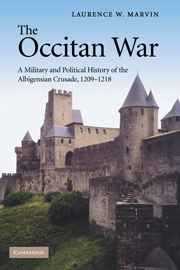Book contents
- Frontmatter
- Contents
- List of abbreviations
- List of maps and plans
- Translation of names and places; calculation of distances
- Preface and acknowledgments
- Maps and plans
- 1 Introduction
- 2 The campaign of 1209
- 3 Simon of Montfort and the campaign of 1210
- 4 The campaigns of 1211
- 5 Drawing the noose: the campaign year of 1212
- 6 The athlete of Christ triumphs: late 1212 through Muret 1213
- 7 From Muret to Casseneuil: September 1213 to December 1214
- 8 The two councils and Prince Louis's crusade, January–December 1215
- 9 The southern counter-attack begins: February 1216 to fall 1217
- 10 The second siege of Toulouse and end of the chief crusader: 1217–1218
- Aftermath and epilogue
- Select bibliography
- Index
2 - The campaign of 1209
Published online by Cambridge University Press: 18 July 2009
- Frontmatter
- Contents
- List of abbreviations
- List of maps and plans
- Translation of names and places; calculation of distances
- Preface and acknowledgments
- Maps and plans
- 1 Introduction
- 2 The campaign of 1209
- 3 Simon of Montfort and the campaign of 1210
- 4 The campaigns of 1211
- 5 Drawing the noose: the campaign year of 1212
- 6 The athlete of Christ triumphs: late 1212 through Muret 1213
- 7 From Muret to Casseneuil: September 1213 to December 1214
- 8 The two councils and Prince Louis's crusade, January–December 1215
- 9 The southern counter-attack begins: February 1216 to fall 1217
- 10 The second siege of Toulouse and end of the chief crusader: 1217–1218
- Aftermath and epilogue
- Select bibliography
- Index
Summary
Virtually all works on the Albigensian Crusade spend an inordinate amount of time on the first year of the war. This is largely due to the storming of Béziers, which is often viewed as establishing a pattern of unforgiving and brutal warfare in the south. For all the ink spilled on it scholars have not studied the campaign year of 1209 with the thoroughness and lack of partisanship it deserves. Much of what has been written about the crusade since the nineteenth century has tended to be anti-church or pro-Occitan, and the events of the year 1209 provide easy fodder for these agendas. The legate Arnaud-Amaury's apocryphal remarks, supposedly made at the height of the sack of Béziers, will never go away, and they have to be dealt with in any discussion of what happened there. No matter who gets the blame, undoubtedly 1209 ushered in a time of troubles for the people of the south.
By 1 March 1209 Innocent's hopes of military intervention in Occitania had come closer to reality when real preparations for a crusade against the lands of the Count of Toulouse began. On that date Innocent appointed a Master Milo legatus a latere for the coming crusade, where he would join Arnaud-Amaury, the Abbot of Cîteaux, who had been a legatus a latere since 1204. Master Milo was reputed to be the pope's personal priest and confessor, a man renowned for his verbal acuity.
- Type
- Chapter
- Information
- The Occitan WarA Military and Political History of the Albigensian Crusade, 1209–1218, pp. 28 - 68Publisher: Cambridge University PressPrint publication year: 2008



